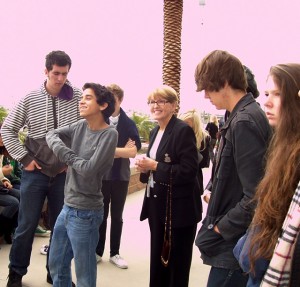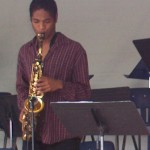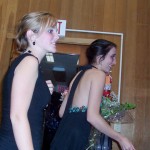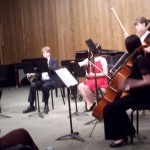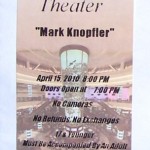Art Show ‘Gleans House’
April 30, 2010“Gleaning House,” the latest art exhibit at Idyllwild Arts Academy, showcases the work of six seniors, including Esther Chung, Dominique DeRoss, Haley Kuhlmann, Natania Frydmann, Joohee Park, Helena Walker and Miriam Grace Leigh.
“It’s a strong show,” said Rob Rutherford, head of the Visual Arts Department at Idyllwild Arts.
The show, which began on Friday night, April 23, at the Parks Exhibition Center, features a variety of media, including acrylic paintings, graphite drawings, ceramic sculptures and a large installation (wood construction).
The works that you see, said Rutherford, have changed a bit from their original proposals.
Months before, Rutherford and his staff reviewed the student’s proposals and artists statements and worked with them on their part of the show. However, two of the artists had changed their plans, including DeRoss and Frydmann.
The “Gleaning House” show title is puzzling. The definition of “gleaning” is the act of collecting leftover crops from farmers’ fields after they have been commercially harvested. Some ancient cultures promoted gleaning as an early form of a welfare system. In fact, the poster for this “Gleaning House” art show featured a single russet potato. By using “gleaning” instead of “cleaning” house, perhaps the students wanted to show that they were giving or offering something, instead of throwing it away.
The first thing you notice when you walk into the gallery is Frydmann’s installation of a house, entitled “Downstairs a Mouse is in a Jar.” About the size of a doll house, it’s made up of wood (2 x 4s and plywood), fabric material (for the roof) and paper (the prints inside).
There’s room enough for a single gold armchair, and all around the walls are small hangings of prints with words on them.
“Go in and sit down,” encouraged Vance Blaettler, director of Design & Graphics at Idyllwild Arts. “It’s meant to be interactive.”
When you sit down on the chair is that there is dirt all over the floor, which is spilling out into the gallery and making quite a mess.
On the outside of the house are graphite drawings, which could be artistic doodlings. Yet, if you were to venture to the back of the house, you’d see a life-sized drawing of a female nude torse with a large nose attached. Obviously, Frydmann can draw too.
The prints on the inside tell more of a personal tale. Someone in her family had cancer, Rutherford said, and she was greatly affected by it.
“In fact, the house was not in her original proposal,” he said, “but she convinced me that it was necessary.”
The house had to be brought into the gallery in pieces, and constructed inside. When the show closes tonight, it has to be broken down again.
“Phylum Acrasiomycota,” the ceramics installation by Dominique DeRoss, also started off differently, Rutherford said.
“Originally, Dominique wanted to mount all of the ceramics onto a wooden log,” he said. “But she had to change those plans in the end.”
He said that it was important to her to have a natural element along with her ceramics because Idyllwild is all about nature, and she’s lived here her entire life.
The title is the name of a spore that grows on a log. That’s why the log was important. Since it didn’t work out, she wanted to put natural clay on top of the white cubes to give it an “earthy” element, but that idea got nixxed.
“Her glazes are nice,” Rutherford said.
Each of DeRoss’ vessels had a different glaze, texture and feel to them. She said the first one was hard to make, but the others were easy. She’s not sure what she’s going to do with all of them (about 25 in all) when the show closes today, April 30, (on her 18th birthday). After the summer, she plans to take a year off and move to Oregon.
Another ceramicist of note was Helena Walker and her six pieces. They also had a nature theme, and she included the scientific name along with the other titles, including encrusint coral, azure sponge, acorn barnacle sponge, brain coral and candy cane coral.
One can imagine that Walker made up the names to match the textures and colors of her strong pieces. Although they wouldn’t be mistaken for corals or sponges, the ceramics were created with much detail to the designs, and the glazes were colors that would gleam in nature.
Miriam Grace Leigh, combined her ceramic pieces (under bell jars) with the framed ink and watercolor paintings on the wall. The paintings, which look organic, remind one of eastern European art, with its elongated features and political influences. In Leigh’s case, however, the titles signify more of a personal journey: Milk Flower,” for one that looks like breast barnacles, and “Screaming Grass” and “Cannibal Plant.”
Esther Chung, whose two acrylic paintings, not only show intense color and grand scale (each 90 x 117 inches), but unusual perspectives. On one of the paintings, Chung has shown her room, perhaps her limited world, from several perspectives, including a bird’s eye view.
Haley Kuhlmann’s “Aging Tragedy,” depicts a series of portraits of a man, from infancy to old age, also caught a lot of attention from attendees.
“Look! the eyes are a different color!” remarked two people from Idyllwild. Indeed, the colors changed from purple, to brown to green, and finally blue. Those same eye colors were repeated by Kuhlmann in large blocks of color at the base of each painting.
“Wow, that’s really cool!” said Juwan Lockett, a theater major, at the aging transformation.
The teenager, looked very much like Bram Rees-Davies, a moving pictures student. However, Kuhlmann wasn’t there to confirm it.
The old age picture, however, depicted a man above age 90, thin, with large eyes. It looked a lot like Yoda, from “Star Wars.” If Rees-Davies went from looking like he is today to looking Yoda-like, it would be a tragedy.
Joohee Park’s “Change,” is an organic looking oversized graphite drawing (37 x 76 inches), that takes up the entire back wall space. Like most seniors, Park is likely reviewing all the changes she has made over the years at Idyllwild Arts, and looking forward to college.
“Gleaning House” closes today, Friday, April 30, at the Parks Exhibition Center on campus. The next senior art show will be next Friday, May 7, at 6 p.m. All shows are free and open to the public. For more information, call (951) 659-2171.













